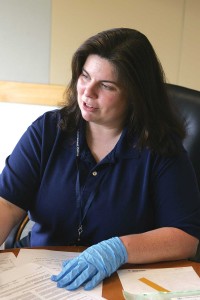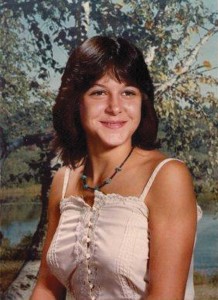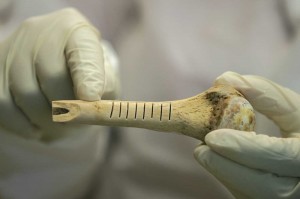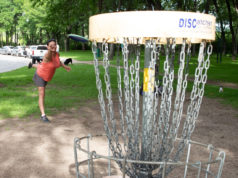What makes NamUs so successful — and different from the FBI’s National Crime Information Center (NCIC) — is that it’s available to everyone, explained Spamer.
NamUs.gov keeps an active database of missing persons, unidentified persons, and unclaimed persons (bodies that have been identified but families haven’t been found to notify). Each database is designed to be searched separately using physical characteristics and information like name and date of birth. But all databases have the same goal: to find and properly identify the missing. So a profile in the missing-persons database could match an entry in the unidentified persons database. Once a family member sets up a missing-person profile, that information is verified by local law enforcement before it is released to the public.
Finding a missing family member listed, unmistakably, among the dead, can of course be a heartbreaking discovery. Each family responds differently, Spamer said. But families appreciate being able to search on NamUs, she said, because most just want to know one way or the other.

“They want to be proactive and do something to help find their loved one,” Spamer said.
“Not knowing is worse than knowing someone is dead,” said Matthews, the communications director for NamUs. He has been working with NamUs longer than anyone at UNT. And he’s the person families call — tearfully or thankfully — when they find information in the database about a family member.
“After 10 or 15 years, they’ve already realized their loved one is dead. They have allowed them to die in their mind,” he said. Finding the confirming information, at last, is “resolution … allowing them to heal.”
Janice Smolinski of Cheshire, Conn., has never found any information about her missing son Billy through NamUs. But she is nonetheless one of the system’s biggest advocates.
In fact, she is working to pass a measure, called “Billy’s Law,” that would require the FBI to share portions of its law-enforcement-only NCIC database with the public NamUs database. The exchange of information would provide a more comprehensive set of missing-persons and unidentified-remains cases, allowing law enforcement to enter information more easily into each system. She believes it could help catch more killers.
Smolinski said law enforcement officials think her handsome 31-year-old son was murdered. If that’s true, identifying his remains might help bring his attacker to justice.
Spamer explained that when skeletal remains are found, they are sometimes so old or degraded that they provide no hints of trauma or cause of death. But just being able to identify the person can help solve the case, she said.
“With a positive ID, law enforcement can backtrack their steps until we know the history leading up to the death and disappearance,” she said. “When that body is identified, it prompts the investigation forward.”
Somershoe, the Phoenix detective, said it’s rare for police to solve a homicide unless they know the victim’s name. “In any homicide case, identifying the victim is the first step — that will lead to finding out who killed that person,” he explained
“All cases are puzzles pieces,” he said. “NamUs invites everyone into the same room to come together to solve the case.”
********
Unlike the actors on popular TV crime dramas like Bones and CSI, scientists at UNT Health Science Center don’t go out to crime scenes, and cases aren’t solved in a 45-minute time slot. Crime scene investigations are handled by local law enforcement agencies, which send samples — like bones, tissue, blood samples, and teeth — to the UNT center for DNA testing.
“DNA testing is what we’re known for,” said Dana Benton-Russell, director of public relations and communications at the health science center.
Flash back to high school science class, and you might remember that there are two types of DNA, nuclear and mitochondrial. Nuclear DNA, from the nuclei of cells, is a combination of the mother’s and father’s DNA profiles. With the exception of identical twins, “the odds of two people have the same nuclear DNA profile are beyond the odds of the population of the planet,” Spamer said.
Mitochondrial testing is a more specialized type of analysis that looks at DNA derived from another part of the cell, the mitochondria, which produces energy. This type of testing is more expensive and more susceptible to contamination, Spamer said, and there are very few labs in the country that do it.
Mitochondrial DNA comes down the maternal bloodline and allows scientists to go further up or down the family tree. Both nuclear and mitochondrial DNA testing are done on every missing- and unidentified- persons case that UNT works.
Spamer recalled a 50-year-old case of a missing woman from New York. Information suggested a possible identity, and UNT scientists confirmed it by making a mitochondrial DNA match using her niece’s DNA — a niece who wasn’t even born when her aunt went missing.
“Most IDs are made by comparing skeletal remains to family members’ DNA,” Spamer said. The most common way to get a family member’s DNA is by a buccal swab, which is achieved by swiping the inside of the mouth with a cotton swab.
In a missing-person case, Spamer said, scientists attempt to get at least two DNA samples from living relatives, and the more closely they are related to the victim, the better.
Those family members’ DNA samples are then uploaded to the FBI’s Combined DNA Index System (CODIS), which is a forensics DNA database. That way, when an unidentified body is found, its DNA is processed and run against existing DNA data in CODIS for a possible match.
Scientists also need a direct reference sample — DNA from some source in the victim’s life before he or she went missing. That could be something like a baby tooth, plucked hair, or a biopsy sample. For missing children, the neonatal screening card that’s taken just after birth works well.
Processing skeletal remains for DNA does look like a scene straight off CSI, and it’s something that UNT Health Science Center does every month.
Leg bones are the best part of the skeleton to use in extracting DNA, Benton-Russell explained. Long bones like femurs retain DNA that’s less degraded. Forces like sunlight, fire, and chemicals can degrade bone and the DNA inside it. Once scientists have the right bone, they clean it and saw small chunks out of it with a Dremel tool.
The samples are then placed in a specialized cryogenic grinder (an $8,000 machine that can turn basically anything into dust). It pulverizes the pieces of bone into a fine powder so DNA can be extracted.
The center provides a top-notch graduate education to future DNA analysts. Within UNT’s graduate school of biomedical science, the forensic genetics program is a highly specialized, two-year master’s program to prepare students for those jobs.
“We have state-of-the-art equipment, and our students get to use current instrumentation, current software, and current chemistry,” said Dr. Rhonda Roby, a UNT associate professor of forensics and investigative genetics.
In the program, students learn what the work of forensic scientists is really like, dispelling the myths created by TV.
The CSI-type shows don’t really bother Roby, though. Anything that gets more people interested in science is a good thing, she said.
********

In some ways, programs like NamUs put the spotlight more strongly than ever on massive human tragedies. Advances in forensic and database technology make it more likely that long-dead remains will be identified, but they do little to stop the various kinds of violence that produce the tragedies.
In the Florida panhandle, there’s a fight under way between the state and the University of South Florida to exhume 50 bodies found in unmarked graves on the property of a shuttered reform school.
The state-run Arthur G. Dozier School for Boys in Marianna had a history of violence and sexual abuse. At one time, it was the largest reform school in the nation, serving almost 700 young boys at a time. After a century of scandal and murderous treatment of its residents, the school shut down in 2011.
Now USF researchers have applied to the state for permission to exhume the bodies in order to identify them. No decision has been made on the exhumations, and while they wait, researchers are collecting DNA samples from family members whose boys may be among those discovered.
Mike Nance, regional system administrator for NamUs, explained that those family-member samples will go to UNT Health Science Center to be processed and loaded into the CODIS database. He works with family members, law enforcement agents, and coroners to find missing persons by obtaining family DNA samples. His work covers much of the southern United States, including Florida and Texas.
At the reform school, “They haven’t started to exhume any bodies yet,” Nance said, “but when they do, the initial investigators will take bodies back to a lab at University of South Florida.” Examiners in Florida will attempt to determine causes of death. After that, material from the remains will be sent to UNT for DNA extraction and for the resulting information to be uploaded into the FBI’s CODIS database. That way, he said, CODIS will have DNA samples of the victims’ living relatives and DNA samples from the bodies found at the school. That information could later be uploaded into NamUs as well.
Nance called the missing and unidentified “our nation’s silent mass disaster.
“It’s just occurring all over the country,” he said. More unidentified bodies are being found, and more people go missing everyday.
In Brooks County in South Texas, the disaster has been in the making for decades. Routinely, the remains of immigrants are found scattered throughout the countryside north of McAllen — the bodies or bones of those killed by smugglers or by the elements as they struggled toward a better life, left without paperwork or relatives to identify them.

“These people walk across the border and they continue to walk … . When they get to Brooks County, that’s the extent of what their human bodies can stand. It’s quite a tragic situation,” Nance said. Those unidentified remains also come to UNT Health Science Center to get processed for DNA.
The American Southwest is just one of the world’s killing fields, of course.
“This problem is global,” said Dr. Arthur Eisenberg, director of UNT’s Center for Human Identification and professor and chairman of the department of forensic and investigative genetics. In places like Africa, where political, tribal, and religious violence has been such a feature of recent decades, it’s impossible to know how many bodies will be found.
In August, a new training laboratory will be completed at the health science center, designed specifically to train forensic scientists from across the world to identify remains found in their home countries.
So far, the center has trained about 50 international scientists. Eisenberg is eager to begin an additional training partnership with Libya later this year. Brutal Libyan dictator Moammar Gadhafi, before his long reign ended in 2011, ordered the deaths of thousands of people. Scientists estimate that there are about 20,000 bodies in mass graves spread throughout the country.
Between 2008 and 2011, Eisenberg and his team helped deal with the aftermath of another dictatorship, this one in Chile. The country’s current government says Augusto Pinochet killed more than 3,000 people from 1973 to 1990. UNT processed more than 1,200 family reference samples and pulled DNA samples from 170 skeletal remains found in Chile. At the UNT center, scientists were able to identify 125 of the 170 sets of remains.
********
Like the new training laboratory at UNT, advances in forensic science and education continue. The latest one could help NamUs begin identifying the living, as well as the dead.
Later this year, an important component will be added to NamUs: a searchable database of the “living unidentified.” That includes individuals (like a Fort Worth man called Smiley) who no longer know their own names or histories.
“Many of the living unidentified people we find are homeless, “ said Matthews.
“Smiley” is about 75 years old, an African-American with gray hair, a beard, and mustache. He was homeless when he was brought into John Peter Smith Hospital last year with cranial bleeding. He doesn’t remember his name or where he came from. His case file is listed on the DOE Network, a nonprofit, volunteer-based organization for listing and finding missing persons. Right now he is living at a local nursing and rehabilitation center. Last week, NamUs employees took fingerprints, a photo, and a DNA sample.
Matthews helped launch the DOE Network in 2001. Many cases on the network don’t include enough information to allow them to be loaded into NamUs. The network isn’t affiliated with any law enforcement agency, although it does aid law enforcement with investigations.
No advance in technology will ever put a name to every unidentified victim, living or dead, of course. But people like Smolinski and Somershoe want more people to understand how great the problem is, and why systems like NamUs are so important.
If her son Billy hadn’t disappeared, Smolinski said, she would still be blind to the problem. She knows that most people don’t understand the enormity of the missing-and-unidentified crisis in the United States.
“A parent never stops worrying about a child; you have a lifetime of memories and bonding,” Smolinski said. “There’s a hole in your heart — not knowing what happened [is] one of the worst things in the world. … It has changed our lives forever.”
Somershoe said a lack of communication among law enforcement departments can make it harder to solve missing-person and unidentified-remains cases.
“NamUs helps us make those connections,” he said. “We used to only have NCIC. It’s good for living people, but when it comes to missing persons who end up as homicides or deaths, the connections aren’t very clear. That’s why there are 40,000 unidentified victims in the United States.”
Stephanie Clack said that after a DNA match confirmed that the young woman’s body found on that Ohio roadside was, in fact, her sister Paula, she did what she had been wanting to do for 22 years: She brought her sister home.
“NamUs has given me back something that I haven’t had in years,” Stephanie said. “Closure.”
Paula’s remains were exhumed from a potter’s field in Ohio, cremated, and taken back to Missouri.
The faceplate on her grave is marked with a rose and a unicorn.
Fort Worth freelancer Sarah Angle writes for national and regional publications.












Special thanks to Senator Cornyn, former Senator Chris Harris and Representative Charlie Geren for securing funding for this lab. It has made a difference in a number of families lives.